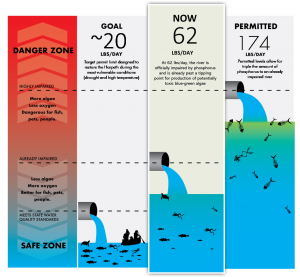Bacteria in the Water
The health of our rivers is critical for environmental sustainability, preservation of wildlife, and clean water protection. River health is determined based on water quality monitoring efforts. Water quality data are utilized to identify and quantify contamination/impairments, inform protection and management strategies, and verify and evaluate management efforts.
Bacteria threaten our waterways and pose health risks to swimmers. Waterborne pathogens (bacteria capable of causing disease in humans) have been known to cause Salmonellosis, Legionnaires’ disease, Dysentery, and other stomach, respiratory, skin, and brain effects. Bacteria sources may include sewage, urban runoff, agricultural runoff, or industrial waste. When these bacteria flow into our beaches and rivers they can pose serious health risks.


Recreational waters are threatened by fecal contamination from urban and agricultural drainage that may contain human pathogens associated with gastrointestinal and respiratory illness. Many recreational beaches and rivers around the United States are monitored for fecal contamination, which indicates a threat to human health. According to the Center for Disease Control, the top causes of recreational water illnesses are human pathogens that can be monitored via E. coli sampling.

Unfortunately, the state of TN performs very little E. coli sampling particularly in our highly recreated rivers (i.e. >500,000 visit the Harpeth River State Parks annually) and none of these sampling efforts are paired with predictive modeling, which provides the general public “early warning” notice if waters may be unsafe to swim based on levels of E. coli. Harpeth Conservancy (HC) strives to mitigate this problem through our Citizen Water Quality Monitoring Program that regularly monitors water quality in Middle Tennessee rivers through our network of citizen scientists. During the 2023 sampling season (May-September), this program focuses on regular sampling of E. coli at highly recreated sections of the Harpeth River, Richland Creek, Mill Creek, Browns Creek, Whites Creek, Cumberland River, and Piney River and pair those data with predictive models that will provide the public with an “early warning” when levels of E. coli are elevated and likely unsafe to be in contact with. This real-time public safety advisory system will launch in 2023 as TN Water Watch. Stay tuned!
Harpeth Conservancy E. coli Modeling Study
The Basics of Predicting E. coli Levels Using a Model
Efforts to monitor recreational waters for fecal contamination have shifted away from culturing pathogen indicator organisms, such as E. coli, to developing real-time predictive models. Culturing E. coli requires 18 to 24 hours to complete; thus, “do NOT swim advisories” are based on previous day measurements– this traditional approach under-performs compared to predictive models. Predictive models, such as a multiple linear regression analysis can utilize a variety of water quality and environmental parameters to correlate elevated levels of E. coli with certain environmental conditions (see graphic to right).

TDEC Coliform Water Quality Criteria
*Geometric Mean found by taking the average of 5 separate samples collected over the span of 30 days – no two samples can be closer than 12 hours apart
*CFU – colony forming units
*2,880 cfu is greater than the TDEC sampling limit of 2400 cfu
Latest Posts

Discharge Permit for Franklin Sewer Treatment Plant
Email Petition Instructions: Use our email petition form to the left in order to send a message to Tennessee Department of Environment and Conservation (TDEC)

Action Alert: Franklin Sewer Permit
YOUR ATTENDANCE AT THE AUGUST 30, 2022 PUBLIC HEARING AND WRITTEN COMMENTS TO TDEC ARE CRITICAL! THE HARPETH RIVER IS STILL IMPAIRED, BUT THE DRAFT











